Advertisements
Advertisements
प्रश्न
In a square ABCD, its diagonals AC and BD intersect each other at point O. The bisector of angle DAO meets BD at point M and the bisector of angle ABD meets AC at N and AM at L. Show that:
- ∠ONL + ∠OML = 180°
- ∠BAM + ∠BMA
- ALOB is a cyclic quadrilateral.
उत्तर
ABCD is a square whose diagonals AC and BD intersect each other at right angles at O.
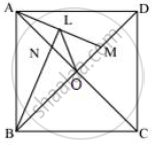
i. ∴ ∠AOB = ∠AOD = 90°
In ΔANB,
∠ANB = 180° – (∠NAB + ∠NBA)
`=>` `∠ANB = 180^circ - (45^circ + (45^circ)/2)` ...(NB is bisector of ∠ABD)
`=> ∠ANB = 180^circ - 45^circ - 45^circ/2 = 135^circ - 45^circ/2`
But, ∠LNO = ∠ANB ...(Vertically opposite angles)
∴ `∠LNO = 135^circ - 45^circ/2` ...(i)
Now in ΔAMO,
∠AMO = 180° – (∠AOM + ∠OAM)
`=> ∠AMO = 180^circ - (90^circ + (45^circ)/2)` ...(MA is bisector of ∠DAO)
`=>∠AMO = 180^circ - 90^circ - (45^circ)/2 = 90^circ - (45^circ)/2` ...(ii)
Adding (i) and (ii)
`∠LNO + ∠AMO = 135^circ - 45^circ/2 + 90^circ - 45^circ/2`
`=>` ∠LNO + ∠AMO = 225° – 45° = 180°
`=>` ∠ONL + ∠OML = 180°
ii. ∠BAM = ∠BAO + ∠OAM
`=> ∠BAM = 45^circ + (45^circ)/2 = 67 1^circ/2`
And
`=>` ∠BMA = 180° – (∠AOM + ∠OAM)
`=> ∠BMA = 180^circ - 90^circ - 45^circ/2`
= `90^circ - 45^circ/2`
= `67 1^circ/2`
∴ ∠BAM = ∠BMA
iii. In quadrilateral ALOB,
∵ ∠ABO + ∠ALO = 45° + 90° + 45° = 180°
Therefore, ALOB is a cyclic quadrilateral.
APPEARS IN
संबंधित प्रश्न
In the given figure, AB is the diameter of a circle with centre O. ∠BCD = 130o. Find:
1) ∠DAB
2) ∠DBA
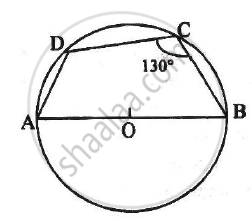
In the figure, given below, find:
- ∠BCD,
- ∠ADC,
- ∠ABC.
Show steps of your working.
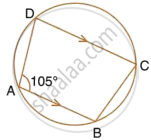
In a cyclic quadrilateral ABCD, ∠A : ∠C = 3 : 1 and ∠B : ∠D = 1 : 5; find each angle of the quadrilateral.
ABCDE is a cyclic pentagon with centre of its circumcircle at point O such that AB = BC = CD and angle ABC = 120°.
Calculate:
- ∠BEC
- ∠BED
The given figure shows a semi-circle with centre O and diameter PQ. If PA = AB and ∠BCQ =140°; find measures of angles PAB and AQB. Also, show that AO is parallel to BQ.
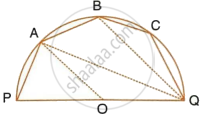
ABCD is a cyclic quadrilateral, AB and DC are produced to meet in E. Prove that ΔEBC ≅ ΔEDA.
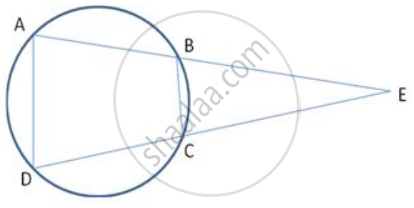
The bisectors of the opposite angles A and C of a cydic quadrilateral ABCD intersect the cirde at the points E and F, respectively. Prove that EF is a diameter of the circle.
In the figure, given below, find: ∠ADC, Show steps of your working.
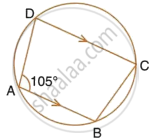
In the figure, given below, find: ∠ABC. Show steps of your working.

The diagonals of a cyclic quadrilateral are at right angles. Prove that the perpendicular from the point of their intersection on any side when produced backward bisects the opposite side.
